Brown spots on plum tree leaves can be a sign of various diseases and pests that can impact the health and productivity of the tree. Identifying the cause of the brown spots is crucial to take appropriate measures to prevent further damage.
In this article, we will explore the common causes of brown spots on plum tree leaves and provide tips on how to prevent and control them.
Plum trees are susceptible to various diseases that can cause brown spots on leaves, including bacterial spot, brown rot, and plum pox virus. Pests such as aphids, mites, and plum curculio can also cause brown spots on leaves and impact the overall health of the tree.
Environmental factors such as drought, heat stress, and nutrient deficiencies can also contribute to the development of brown spots on leaves. By understanding the underlying causes of brown spots, growers can take proactive measures to prevent and control them.
Key Takeaways
- Identifying the cause of brown spots on plum tree leaves is crucial to take appropriate measures to prevent further damage.
- Plum trees are susceptible to various diseases and pests that can cause brown spots on leaves, including bacterial spot, brown rot, and plum pox virus.
- Environmental factors such as drought, heat stress, and nutrient deficiencies can also contribute to the development of brown spots on leaves.
You shouldn’t miss on these other top posts:
Identifying Brown Spots on Plum Tree Leaves
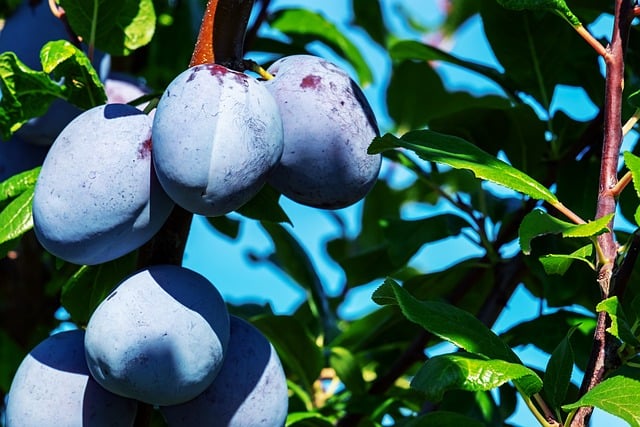
Brown spots on plum tree leaves are a common problem that can affect the health and yield of the tree. These brown spots can be caused by various factors, including fungal and bacterial infections, environmental stress, or insect damage. Identifying the cause of brown spots is essential to determine the appropriate treatment.
1. Symptoms
Brown spots on plum tree leaves can appear as small or large circular or irregular-shaped patches on the leaves. The spots can be light brown, dark brown, or black in color, and may have a yellow halo around them. In severe cases, the spots can merge, causing the leaves to turn brown and die.
2. Leaf Spot
Leaf spot is a common fungal disease that causes brown spots on plum tree leaves. The fungal spores can spread through water, wind, or insects. The disease can affect the photosynthesis process, causing the leaves to lose their green color and eventually fall off.
Leaf spot can be prevented by maintaining good tree hygiene, pruning infected branches, and applying fungicides.
3. Environmental Stress
Environmental stress, such as drought, extreme heat, or cold temperatures, can also cause brown spots on plum tree leaves. When the tree is under stress, it may not be able to absorb enough water and nutrients, leading to brown spots and leaf loss.
To prevent environmental stress, it is important to provide the tree with adequate water, nutrients, and protection from extreme weather conditions.
4. Insect Damage
Insect damage can also cause brown spots on plum tree leaves. Insects such as aphids, mites, and scale can feed on the leaves, causing them to turn brown and fall off. Insect damage can be prevented by using insecticides and maintaining good tree hygiene.
Identifying the cause of brown spots on plum tree leaves is crucial to determine the appropriate treatment. By maintaining good tree hygiene, providing adequate water and nutrients, and applying fungicides and insecticides when necessary, the tree can recover and produce healthy fruit.
Common Diseases Causing Brown Spots
Plum trees can be affected by various diseases that cause brown spots on their leaves. These diseases can be caused by fungi, bacteria, or viruses. In this section, we will discuss some of the most common diseases that cause brown spots on plum tree leaves.
Fungal Diseases
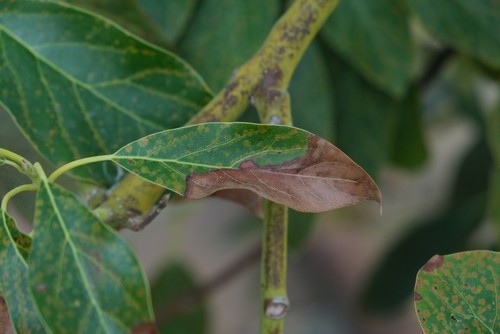
Fungal diseases are some of the most common diseases that affect plum trees. They can cause brown spots on the leaves and other symptoms such as cankers, wilting, and dieback. Some of the most common fungal diseases that cause brown spots on plum tree leaves include:
- Brown rot: Brown rot is a fungal disease caused by Monilinia fructicola. It can cause brown spots on the leaves, fruit, and twigs of plum trees. It can also cause the fruit to rot and become mummified.
- Coryneum blight: Coryneum blight is a fungal disease caused by Coryneum beijerinckii. It can cause brown spots on the leaves and cankers on the twigs of plum trees. It can also cause the fruit to become deformed and drop prematurely.
- Plum leaf spot: Plum leaf spot is a fungal disease caused by Blumeriella jaapii. It can cause brown spots on the leaves of plum trees, which can then turn yellow and fall off. It can also cause defoliation and reduced fruit production.
- Powdery mildew: Powdery mildew is a fungal disease caused by various species of fungi. It can cause a white powdery coating on the leaves of plum trees, which can then turn brown and fall off. It can also cause reduced fruit production.
Bacterial Diseases
Bacterial diseases can also cause brown spots on the leaves of plum trees. They can cause other symptoms such as cankers, wilting, and dieback. Some of the most common bacterial diseases that cause brown spots on plum tree leaves include:
- Bacterial leaf spot: Bacterial leaf spot is a bacterial disease caused by Xanthomonas campestris. It can cause brown spots on the leaves of plum trees, which can then turn yellow and fall off. It can also cause defoliation and reduced fruit production.
- Bacterial spot: Bacterial spot is a bacterial disease caused by various species of bacteria. It can cause brown spots on the leaves of plum trees, which can then turn yellow and fall off. It can also cause defoliation and reduced fruit production.
- Crown gall: Crown gall is a bacterial disease caused by Agrobacterium tumefaciens. It can cause brown spots on the leaves of plum trees, which can then turn yellow and fall off. It can also cause cankers on the roots and trunk of the tree.
Viral Diseases
Viral diseases are less common than fungal and bacterial diseases, but they can still cause brown spots on the leaves of plum trees. They can cause other symptoms such as stunting, yellowing, and distorted growth. Some of the most common viral diseases that cause brown spots on plum tree leaves include:
- Plum pox virus: Plum pox virus is a viral disease caused by Plum pox virus. It can cause brown spots on the leaves of plum trees, which can then turn yellow and fall off. It can also cause reduced fruit production and quality.
- Septoria: Septoria is a viral disease caused by various species of fungi. It can cause brown spots on the leaves of plum trees, which can then turn yellow and fall off. It can also cause defoliation and reduced fruit production.
- Venturia: Venturia is a viral disease caused by Venturia spp. It can cause brown spots on the leaves of plum trees, which can then turn yellow and fall off. It can also cause defoliation and reduced fruit production.
Impact of Pests on Plum Trees
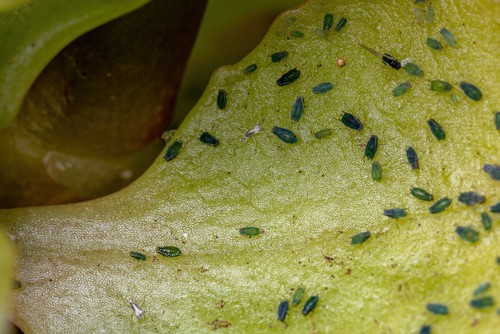
Common Pests
Plum trees are susceptible to a variety of pests that can cause damage to the tree and its fruit. Some of the most common pests that affect plum trees include aphids, scale insects, thrips, moths, and beetles. These pests can cause damage to the leaves, flowers, and fruit of the tree, leading to reduced yields and poor fruit quality.
Aphids are small, pear-shaped insects that feed on the sap of the tree. They can cause leaves to curl and distort, and can also transmit viruses to the tree. Scale insects are another common pest that can cause damage to the tree.
They attach themselves to the branches and leaves of the tree and feed on the sap, causing the leaves to turn yellow and eventually fall off.
Thrips are tiny insects that feed on the flowers and fruit of the tree. They can cause damage to the fruit, causing it to become misshapen and discolored. Moths and beetles can also cause damage to the fruit of the tree, as they feed on the fruit and lay their eggs on the leaves and branches of the tree.
Pests Related Diseases
In addition to causing direct damage to the tree, pests can also lead to the development of diseases. One of the most common pests related diseases that affect plum trees is the plum curculio.
This pest lays its eggs on the fruit of the tree, causing it to become deformed and discolored. The larvae then feed on the fruit, causing it to rot and fall off the tree.
To prevent pests from damaging plum trees, it is important to take preventive measures such as using pesticides and insecticidal soap. These products can help to control the population of pests and prevent them from causing damage to the tree.
It is also important to monitor the tree for signs of pests and diseases, and to take action as soon as they are detected.
Role of Environmental Factors
The development of brown spots on plum tree leaves can be influenced by various environmental factors. The following factors can play a role in the development of brown spots:
1. Water
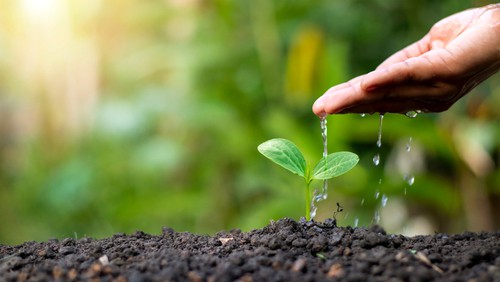
Water is essential for the growth and development of plum trees, but too much or too little water can lead to brown spots on the leaves. Overwatering can cause waterlogged soil, which can lead to root rot and fungal diseases. On the other hand, drought stress can cause the leaves to wilt and develop brown spots.
2. Sunlight
Plum trees require full sun to thrive, but too much sun exposure can lead to sunburn and brown spots on the leaves. Sunburn occurs when the leaves are exposed to intense sunlight for an extended period. It can cause the leaves to turn brown and dry out.
3. Wet Conditions
Wet conditions can create a favorable environment for fungal diseases that can cause brown spots on the leaves. Plum trees require well-draining soil to prevent waterlogging, which can lead to root rot and fungal diseases.
4. Moist Conditions
Moist conditions can also create a favorable environment for fungal diseases that can cause brown spots on the leaves. It is essential to maintain proper airflow around the tree to prevent moisture buildup and reduce the risk of fungal diseases.
5. Airflow
Good airflow is essential for the health of plum trees. Poor airflow can lead to moisture buildup, which can create a favorable environment for fungal diseases. It is essential to prune the tree regularly to improve airflow and reduce the risk of fungal diseases.
6. Spacing
Proper spacing is essential for the health of plum trees. Overcrowding can lead to poor airflow and moisture buildup, which can create a favorable environment for fungal diseases. It is essential to plant plum trees at the recommended spacing to prevent overcrowding and reduce the risk of fungal diseases.
Prevention and Control Measures
Proper Pruning
One of the most effective ways to prevent and control brown spots on plum tree leaves is through proper pruning. Pruning helps to improve air circulation and sunlight exposure, which reduces humidity and the likelihood of fungal growth. It also helps to remove infected leaves and branches before the disease can spread further.
When pruning, it is important to use clean, sharp tools to avoid damaging the tree. Prune during the dormant season, and remove any dead or diseased branches, as well as any branches that are rubbing against each other. Prune back any branches that are blocking sunlight from reaching the center of the tree.
Use of Fungicides and Pesticides
Another way to prevent and control brown spots on plum tree leaves is through the use of fungicides and pesticides. Fungicides can be used to prevent and treat fungal infections, while pesticides can be used to control pests that may be spreading the disease.
When using fungicides and pesticides, it is important to follow the manufacturer’s instructions carefully. Wear protective clothing and avoid spraying during windy conditions. Some common fungicides for plum trees include Chlorothalonil and Myclobutanil.
Proper Watering and Sunlight Exposure

Proper watering and sunlight exposure are also important for preventing and controlling brown spots on plum tree leaves. Overwatering can lead to standing water and increased humidity, which can promote fungal growth. Use a soaker hose or drip irrigation system to water the tree slowly and deeply, and avoid watering the leaves.
Plum trees also need plenty of sunlight to thrive. Make sure the tree is planted in a location where it will receive at least 6 hours of direct sunlight each day. If the tree is not getting enough sunlight, consider pruning nearby trees or removing obstacles that may be blocking the sun.
In addition to these prevention and control measures, it is important to fertilize the tree regularly with a balanced fertilizer to promote healthy growth and prevent stress. If the brown spots on the plum tree leaves persist despite these treatments, consider consulting a professional arborist for additional advice and treatments.
Nutrition and Care for Plum Trees
Plum trees are a type of fruit tree that requires proper care and nutrition to produce a healthy fruit crop. Here are some tips to help you care for your plum trees:
1. Nutrients
Plum trees require several nutrients to grow and produce fruit. These nutrients include nitrogen, phosphorus, potassium, calcium, and magnesium. Nitrogen is essential for leaf growth, while phosphorus and potassium are necessary for flower and fruit development. Calcium and magnesium help with overall tree health and fruit quality.
2. Compost
Compost is an excellent source of nutrients for plum trees. It provides organic matter and helps improve soil structure and fertility. Apply a layer of compost around the base of the tree each year to provide a slow-release source of nutrients.
3. Fruit Drop
Fruit drop is a common problem in plum trees. It occurs when the tree drops immature or damaged fruit. To prevent fruit drop, make sure the tree receives adequate water and nutrients. Thinning the fruit can also help reduce fruit drop and improve fruit size and quality.
4. Pruning
Pruning is essential for maintaining the health and productivity of plum trees. It helps remove dead or diseased wood, improves air circulation, and promotes new growth. Prune the tree in late winter or early spring before the buds begin to swell.
5. Pest and Disease Control
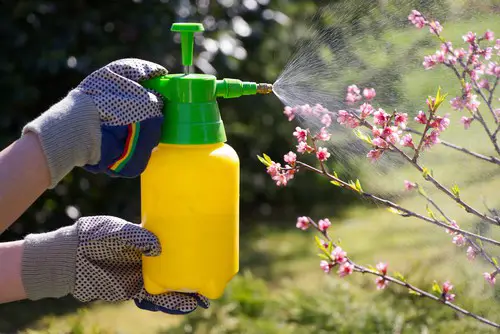
Plum trees are susceptible to several pests and diseases, including plum curculio, brown rot, and bacterial spot. To control pests and diseases, use integrated pest management practices, including regular monitoring, cultural controls, and, if necessary, chemical controls.
By following these tips, you can help ensure that your plum trees produce a healthy fruit crop year after year.
Brown Spots on Other Fruit Trees
Stone fruit trees, including apricots, cherries, peaches, and nectarines, are susceptible to brown spots on their leaves, caused by various fungal diseases. These diseases can weaken the fruit trees and reduce crop yields.
1. Apricots
Apricot trees can develop brown spots caused by the fungus Alternaria mali. The spots are initially small and dark, but they can expand and merge, causing leaves to wilt and fall prematurely.
The disease can also affect the fruit, causing brown spots that can lead to rot. To prevent the spread of the disease, it is recommended to prune the affected branches and remove any fallen leaves and fruit from the ground. Fungicides can also be used to control the disease.
2. Cherries
Cherry trees can be affected by the fungal disease called cherry leaf spot, caused by the fungus Blumeriella jaapii. The disease causes brown spots on the leaves, which can lead to defoliation and reduced fruit quality.
The disease can be prevented by maintaining good tree hygiene, such as removing fallen leaves and fruit from the ground, and pruning the affected branches. Fungicides can also be used to control the disease.
3. Peaches
Peach trees can develop brown spots on their leaves caused by the fungal disease called peach leaf curl, caused by the fungus Taphrina deformans. The disease causes the leaves to curl and become distorted, with brown spots appearing on the upper surface.
The disease can also affect the fruit, causing it to become distorted and drop prematurely. To control the disease, it is recommended to prune the affected branches and apply a fungicide in the fall after the leaves have dropped.
4. Nectarines
Nectarine trees can be affected by the fungal disease called shot hole, caused by the fungus Wilsonomyces carpophilus. The disease causes circular brown spots on the leaves, which can lead to defoliation and reduced fruit quality.
The disease can be prevented by maintaining good tree hygiene, such as removing fallen leaves and fruit from the ground, and pruning the affected branches. Fungicides can also be used to control the disease.
Conclusion
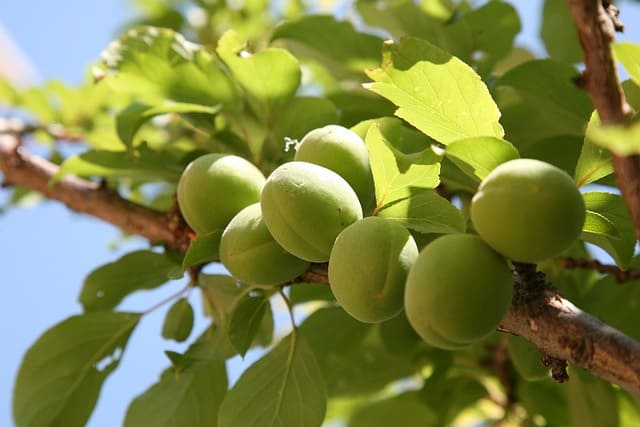
Brown spots on plum tree leaves can be caused by a variety of factors, including fungal infections, bacterial infections, pests, and environmental stressors.
Home gardeners and orchard managers should be vigilant in monitoring their plum trees for signs of disease or infestation, and take appropriate measures to prevent and treat problems as they arise.
When selecting plum tree cultivars, it is important to choose varieties that are resistant to common diseases and pests. Some cultivars, such as ‘Stanley’, ‘President’, and ‘Italian’, are known for their resistance to brown rot and other fungal infections.
To prevent interrupting photosynthesis, which can lead to brown spots on leaves, it is important to ensure that plum trees receive adequate sunlight and water.
Trees and shrubs should be pruned regularly to remove dead or diseased branches, and fallen leaves and other debris should be removed from around the base of the tree to prevent the spread of disease.
If brown spots do appear on plum tree leaves, it is important to identify the underlying cause and take appropriate action. Fungal infections can often be treated with fungicides, while bacterial infections may require the removal of infected branches or even the entire tree.
Frequently Asked Questions
How do you treat plum leaf spots?
Plum leaf spots can be treated with fungicides such as copper-based sprays or captan. It is important to apply the fungicides as soon as the first signs of the disease are noticed to prevent the spread of the fungus.
Additionally, removing infected leaves and debris from around the tree can help prevent the disease from spreading.
What causes brown spots on tree leaves?
Brown spots on tree leaves can be caused by a variety of factors including fungal or bacterial infections, insect damage, environmental stress, or nutrient deficiencies. Identifying the cause of the brown spots is important to determine the appropriate treatment.
How do you treat brown spots on tree leaves?
The treatment for brown spots on tree leaves depends on the underlying cause. Fungal or bacterial infections can be treated with fungicides or bactericides, respectively.
Insect damage can be treated with insecticides. Environmental stress can be reduced by providing proper watering and fertilization. Nutrient deficiencies can be addressed by adding the appropriate nutrients to the soil.
How do you get rid of brown rot on plum trees?
Brown rot on plum trees can be treated with fungicides such as captan or thiophanate-methyl. It is important to prune and remove any infected fruit or branches to prevent the spread of the disease.
Additionally, providing proper air circulation and avoiding over-watering can help prevent the disease from spreading.
What are some plum tree diseases and treatments?
Some common plum tree diseases include brown rot, plum pox virus, and bacterial spot. Brown rot can be treated with fungicides, while plum pox virus has no cure and infected trees must be removed. Bacterial spot can be treated with copper-based sprays or bactericides.
How can you prevent brown spots on plum tree leaves?
Preventing brown spots on plum tree leaves involves proper tree care practices such as providing adequate water and nutrients, pruning to promote air circulation, and removing infected leaves and debris from around the tree.
Additionally, applying fungicides preventatively can help prevent the spread of fungal diseases.

Hey, I’m Lisa and I’ve been an avid gardener for over 30 years. I love writing, talking and living in the garden! Feel free to connect with me on my socials below


